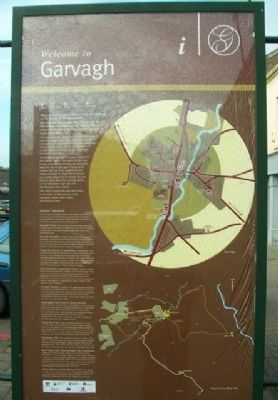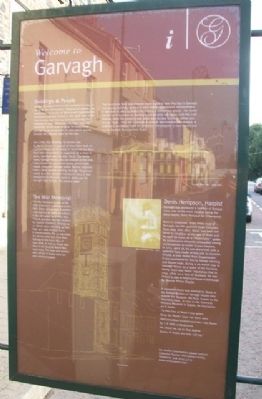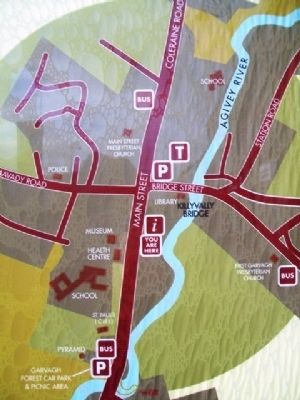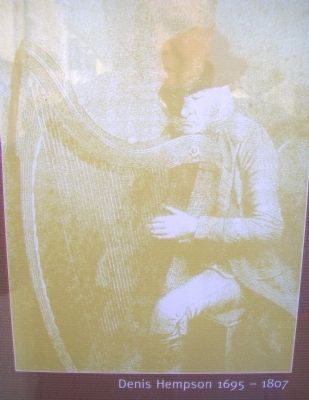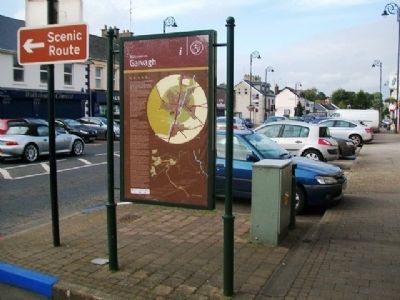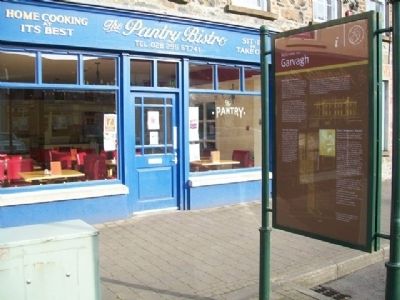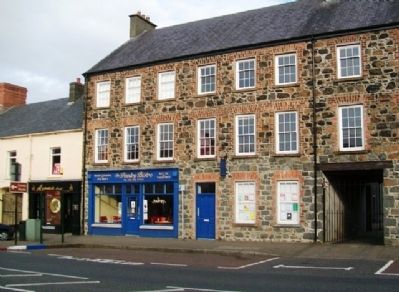Garvagh in Causeway Coast and Glens, Northern Ireland, United Kingdom — Northwestern Europe (the British Isles)
Welcome to Garvagh
Side A
Welcome to the historic town of Garvagh, situated on the banks of the Agivey River.
We hope you enjoy your visit. Please use the information and maps on this sign to find out about the history of Garvagh and to discover its many attractions.
The name Garvagh comes from an old Irish term meaning 'rough place'. The area around the town is steeped in history, and there are many intriguing relics from the past, such as old church ruins, ancient graves and stone circles. You'll even discover a pyramid!
The history of Garvagh is closely linked with the Canning family. They came to this area in 1614, when George Canning was appointed Agent for the Ironmongers' Company of London. His son, Paul, established the village and built St. Paul's Parish Church as a private chapel for the family. You can find out more about the Canning family on the information sign near the War Memorial (town clock).
Take time to study this sign and others in the town, so that you can enjoy the area's historic sites, walks and driving routes.
Historic Townland
The area around Garvagh contains many historic sites and monuments, some of which have survived from pre-history. Here are details of attractions, walks and places of interest to visit while in Garvagh and the surrounding area.
Garvagh Forest: Formerly part of the Canning estate and covering over 200 hectares, Garvagh Forest has eleven kilometres of public paths and roads winding through both conifer and broadleaved trees.
Garvagh Pyramid: Garvagh Forest contains an unusual monument in the form of a pyramid, erected in the 19th century by Lord Garvagh following his grand tour of Egypt. His wish to be laid to rest there was not carried out. Today it stands in splendid isolation among the trees and close to the car park.
Errigal Old Church & Souterrain: A small church, said to have been founded by St. Adhamhnan, was built at Errigal around 560 A.D. It was attacked and rebuilt many times until it was completely destroyed after the 1641 rebellion. The nearby Souterrain was excavated in 1935, revealing a number of chambers, passages and objects, including a sharpening stone and a wooden club, which hint at its use as a refuge in times of danger.
Gortnamoyagh Inauguration Stone: A round shaped piece of rock protrudes from a hillside within Gortnamoyagh Forest, some 500m from Errigal Old Church, with the imprint of two footprints carved into its surface. Used during inauguration ceremonies up until the 16th century, a new chieftain would have stood in the footprints, symbolising his right to follow in the footsteps of his forefathers.
Garvagh Museum: Located in the walled garden of what was Garvagh House, Garvagh Museum is a treasure trove, housing over 2,000 fascinating artefacts that epitomize life in this rural community from 3,000BC through to the first half of the 20th century. The museum's collection provides a fascinating insight into life in the home, the farm and the town.
Desertoghill Old Church & Burial Ground: Said to have been founded by St. Columbkille in the 5th century. Not far from the church is a holy well dedicated to St. Columbkille and on the north side of the church there is a stone called St. Columbkille's stone - the impression on it believed to have been produced by the Saint's knee. The church was abandoned in 1784, when a new church was built at Moyletra, 1.5 miles south east of the original church.
Errigal Glen Trail: This waymarked walking trail, approx. 2.5 miles long, starts and finishes at Errigal Bridge on Temple Road. The trail follows the fast flowing Agivey River through the well wooded Glen and along country roads, forest track and open hillside. Observe the ancient remains of Errigal Old Church and souterrain, and visit the Gortnamoyagh Inaugural Stone.
Drumbane Trail: This waymarked walking trail offers three options, varying from approx. 6-8 miles, and crossing open moorland, farm lanes and country roads. In good visibility, there are fine panoramic views of the Antrim Hills, Bane Valley, Donegal and even the Mourne Mountains from the summit of Drumbane Hill (250m).
Bann Valley Cycle Route & Eagle's Glen Cycle Route: A series of 12 short, circular, signed cycle routes have been developed in the wider Sperrins region. The Bann Valley (Route 12 - approx. 16 miles) and Eagle's Glen (Route 11 - approx. 14 miles) Cycle Routes are two signed cycle routes starting and finishing in Garvagh Forest. Both routes utilise quiet country roads and offer cyclists stunning scenery and opportunities to experience archaeological and historical sites of interest.
North Sperrins Scenic Driving Route: This signed 50 mile circular route winds its way through the beautiful, wild and rugged Sperrin Mountains, passing through the towns of Dungiven, Draperstown, Tobermore, Maghera and Garvagh.
Side B
Buildings & People
George Canning arrived in this townland in 1614 as Agent for the Ironmongers' Company of London. He established the hamlet of Ballinameen (opposite the entrance to Garvagh Forest) on the south side of the river in 1620, but this was destroyed during the rebellion of 1641. When his son, Paul, acquired ownership of the lands in 1659, he established Garvagh on its present site in 1660 and it quickly became the principle town for the area.
One of the first buildings he erected was St. Paul's Church. It appears to have been built as a private chapel for the family in 1659 and may have been later remodeled, as suggested by a stone it bears, inscribed with the date '1670'. The family home, Garvagh House, was also erected at this time. It was located in a 670 acre estate, which today largely comprises Garvagh Forest. Having originally been a fairly modest dwelling, Garvagh House was rebuilt as a fine Georgian mansion in 1813. It was demolished in the early 1960s to make way for Garvagh High School, still present today.
The War Memorial
The War Memorial is one of the most prominent landmarks in the Main Street of Garvagh. A sombre construction, as befits its subject, it was designed by a local man, Thomas Johnston and was unveiled by Captain Charles E. Stronge on 27 March 1924. Standing 40 feet high and built of local stone, it commemorates the 32 men from the district who lost their lives fighting in the Great War of 1914-1918, as well as those who died in the Second World War, 1939-1945. The men and women who served in these wars are also commemorated.
[Garvagh Community Building]
The handsome brick and dressed stone building near this sign is Garvagh Community Building, opened in 2001 following extensive refurbishment. It was built in 1861 by Robert Robertson, a prosperous grocer. His family carried on in business as hardware and general merchants until the 20th century, when the property was taken over by two brothers, Alfred and George Clyde. They ran hardware & general merchandise and drapery & undertaker businesses from the premises. The property is now owned and run by Garvagh Development Trust.
Denis Hempson, Harpist
Garvagh has produced a number of famous sons, one of the most notable being the blind harpist, Denis Hempson (or O'Hampsey).
Born in Craigmore, three miles west of Garvagh, his life spanned three centuries, from 1695 until 1807. Denis had been left blind by smallpox at the age of three and he took up music as a "respectable" career. He possessed a virtuosity unequalled among contemporary or earlier known harpists. In 1713, aged 18, he was presented with a splendid harp made of bog oak by Cormick O'Kelly, a harp maker from Draperstown. It was purchased for him by George Canning and Squire Gage, during a six month stay at Garvagh House as a guest of the Canning family. Such was Denis' reputation that in 1745, while on a tour of Scotland, he was invited to play at Holyrood House in Edinburgh for Bonnie Prince Charlie.
A memorial stone was erected to Denis in the former garden of Garvagh House now outside the Museum. His harp, known as the 'Downhill Harp', is now in the Guinness Brewery Museum in Dublin. An inscription on it reads:
"In the time of Noah I was green
Since his flood I have not been seen
Until seventeen hundred and two I was found
By C R Kelly underground
He raised me up to that degree
Queen of music you may call me."
Erected by Coleraine Borough Council, Environment & Heritage Service, Northern Ireland Tourist Board, et al.
Topics. This historical marker is listed in these topic lists: Industry & Commerce • Patriots & Patriotism • Settlements & Settlers. A significant historical date for this entry is March 27, 1924.
Location. 54° 58.958′ N, 6° 41.249′ W. Marker is in Garvagh, Northern Ireland, in Causeway Coast and Glens. Marker can be reached from Main Street (A 29), on the right when traveling north. Marker is in front of the Community Building. Touch for map. Marker is at or near this postal address: 85 Main Street, Garvagh, Northern Ireland BT51 5ABI, United Kingdom. Touch for directions.
Other nearby markers. At least 2 other markers are within walking distance of this marker. World Wars Memorial (within shouting distance of this marker); a different marker also named Welcome to Garvagh (within shouting distance of this marker).
Related marker. Click here for another marker that is related to this marker.
Also see . . . Garvagh. Wikipedia
entry (Submitted on November 4, 2023, by Larry Gertner of New York, New York.)
Credits. This page was last revised on November 4, 2023. It was originally submitted on December 13, 2013, by William Fischer, Jr. of Scranton, Pennsylvania. This page has been viewed 1,017 times since then and 80 times this year. Photos: 1, 2, 3, 4, 5, 6, 7. submitted on December 13, 2013, by William Fischer, Jr. of Scranton, Pennsylvania.
